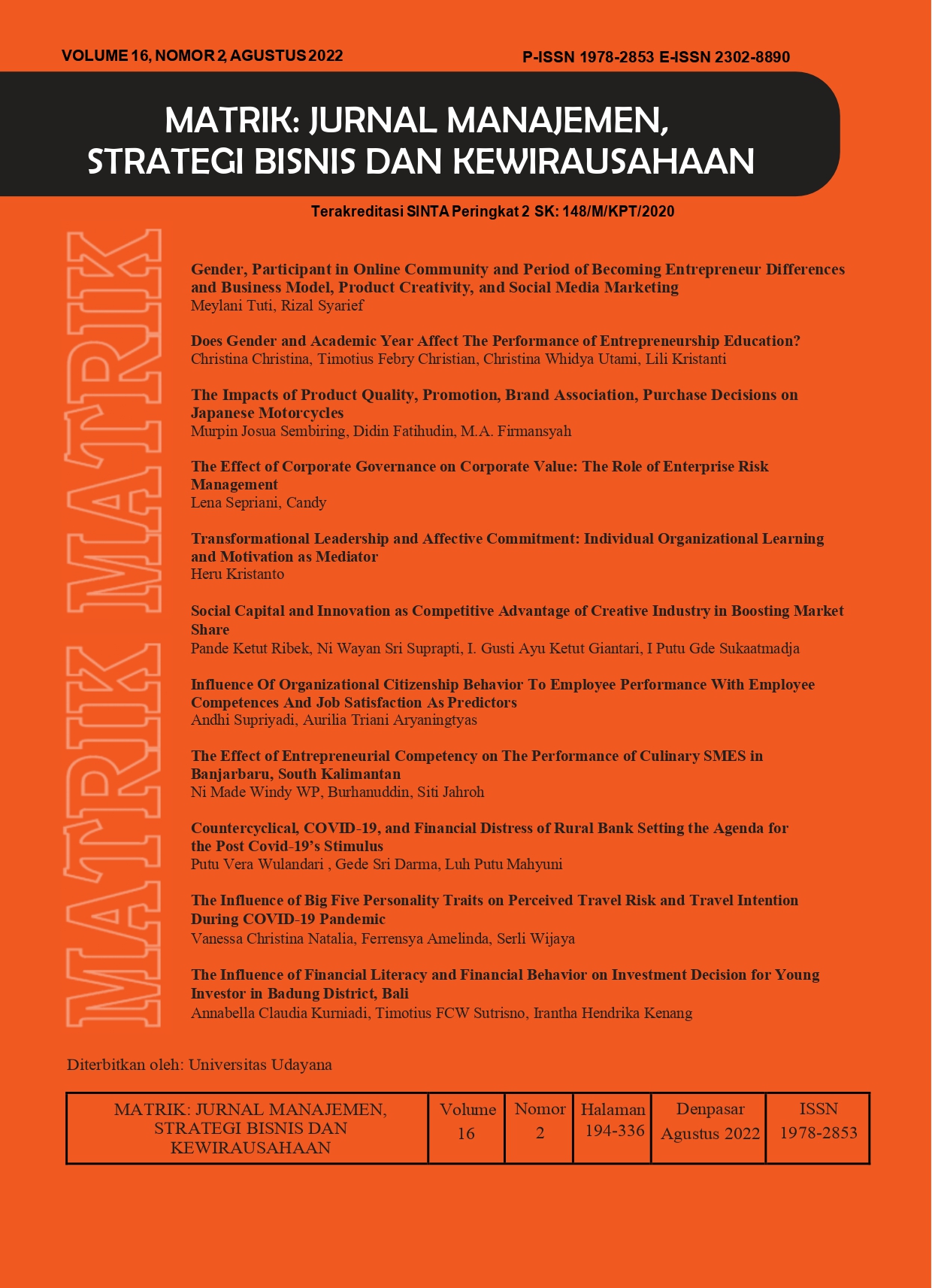The Impacts of Product Quality, Promotion, Brand Association, Purchase Decisions on Japanese Motorcycles
Abstrak
ABSTRACT
Increasing competition in the automotive world requires every automotive company, especially motorcycle manufacturers, to innovate the development of tastes and market needs. All motorcycle manufacturers, especially Japanese motorcycle manufacturers, keep fighting to win the hearts of consumers and hope that their products can dominate the motorcycle market in Indonesia. They must apply their business strategy appropriately to meet their targeted markets. This study aims to determine the effect of product quality, promotion, and brand association of purchasing decisions using quantitative research methods that are objective, including the collection and analysis of statistical testing data. Using the SPSS program, the data of the present study result in the following regression equation: Y = - 0.558 + 0.158X1 + 0.235X2 + 0.196X3+e. Based on the hypothesis testing, the F test results show that the independent variables of product quality, promotion, and brand association simultaneously influence the purchase decision. In comparison, the t-test shows that brand association is a variable that significantly influences customers’ purchasing decisions.
##plugins.generic.usageStats.downloads##
Referensi
Akbar, M., & Wymer, W. (2017). Refining the conceptualization of brand authenticity. J Brand Management, 24(1), 14–32. https://doi.org/doi:https://doi.org/10.1057/s41262-016-0023-3
Assauri, S. (2011). Manajemen pemasaran dasar, konsep, dan strategi. PT. Raja Grafindo Persada.
Barsalou, L. (1991). Deriving categories to achieve goals. The Psychology of Learning and Motivation Advances in Research and Theory, 27(1), 1–64.
Bell, M. (2008). Modern marketing management. Liberty Offset.
Bucklin, R., Lattin, J., Ansari, A., Gupta, S., Bell, D., Coupey, E., . . . Steckel, J. (2002). Choice and the internet: From clickstream to research stream, marketing Letters. 13(3), 245–258.
Durianto, D., & Sugiarto, T.S. (2001). Stategi menaklukkan pasar melalui riset ekuitas dan perilaku merek. PT. Gramedia Pustaka.
Fatihudin, D., & Firmansyah, A. (2019). Pemasaran jasa: Strategimengukur kepuasan dan loyalitas pelanggan. Deepublish Publisher.
Fatihudin, D. (2019). Research methods for economics, management, and accounting from theory to practice. Zifatama Publisher.
Firmansyah, M.A, & Mahardhika, B.W. (2015). Pengaruh strategi marketing mix (produk, harga, promosi, dan distribusi) terhadap keputusan pembelian konsumen batik di Surabaya. BALANCE: Economic, Business, Management and Accounting Journal, 12(2), 18-27
Firmansyah, M., & Fatihudin, D. (2017). Marketing globalization. Deepublish Publisher.
Firmansyah, M. (2019). Marketing: basic and concept. Penerbit Qiara Media.
Gitosudarmo, I. (2008). Pengantar Bisnis (9 ed.). BPFE.
Goh, K., Heng, C., & Lin, Z. (2013). Social media brand community and consumer behavior: Quantifying the relative impact of user-and marketer-generated content. Information Systems Research, 24(1), 88–107.
Gozali, I. (2011). Aplikasi analisis multivariate dengan program SPSS. BP Universitas Diponegoro.
Kotler, A., & Amstrong, G. (2016). Principle of marketing sixteenth edition global edition. In 16. Pearson Education Limited.
Kotler, P., & Keller, K. (2012). Marketing management. Pearson Education.
Kristianto, L.K. (2011). Integrasi ilmu psikologi dalam kegaitan pemasaran. CAPS.
Laksana, F. (2008). Marketing management. Graha Ilmu.
Lunenburg, F. (2010). Group decision making. National Forum of Teacher Education Journal, 20(3), 1–7.
Moe, W.W., & Fader, P.S. (2004). Capturing evolving visit behavior in clickstream data. Journal of Interactive Marketing, 18(1), 5-19.
Murphy, G., & Medin, D. (1985). The role of theories in conceptual coherence. Psychological Review, 92–3(289–295).
Park, Y. H., & Fader, P. (2004). Modeling browsing behavior at multiple websites. Marketing Science, 23(3), 280–303.
Puccinelli, N., Goodstein, R., Grewal, D., Price, R., Raghubir, P., & Stewart, D. (2009). Customer experience management in retailing: Understanding the buying process. Journal of Retailing, 85(1), 15–30.
Sari, N., & Santika, I. (2017). Pengaruh brand image, brand association, dan brand awareness terhadap repurchase intention produk smartphone merek Asus. E-Jurnal Manajemen Universitas Udayana, 6(8), 4099–4126.
Tjiptono, F. (2015). Marketing strategy. ANDI.
Weenas, J. R. (2013). Kualitas produk, harga, promosi dan kualitas pelayanan pengaruhnya terhadap keputusan pembelian Spring Bed Comforta. Jurnal EMBA: Jurnal Riset Ekonomi, Manajemen, Bisnis Dan Akuntansi, 1(4), 607–618.
Wells, J., Valacich, J., & Hess, T. (2011). What signals are you sending? How website quality influences perceptions of product quality and purchase intentions. MIS Quarterly, 35(2), 373–396.
Yadav, M., & Pavlou, P. (2014). Marketing in computer-mediated environments: research synthesis and new directions. Journal of Marketing, 78(1), 20–40.
 This work is licensed under a Creative Commons Attribution-ShareAlike 4.0 International License.
This work is licensed under a Creative Commons Attribution-ShareAlike 4.0 International License.


















